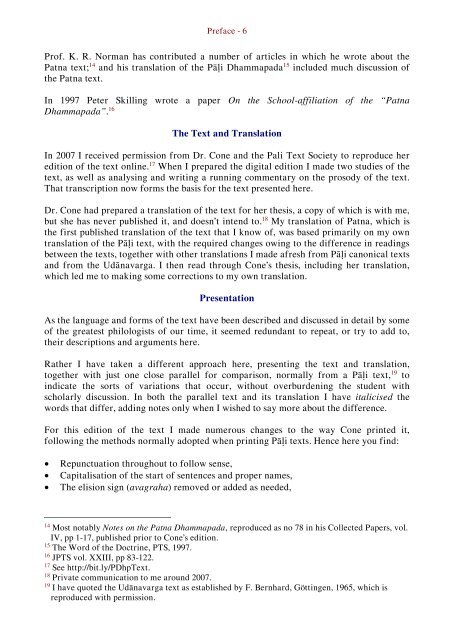Patna Dhammapada, Patna Dhamma Verses
A text and translation of the collection of the Dhammapada verses maintained in Patna, India, together with parallels.
A text and translation of the collection of the Dhammapada verses maintained in Patna, India, together with parallels.
- TAGS
- dharma
- dhamma
- dhammapada
You also want an ePaper? Increase the reach of your titles
YUMPU automatically turns print PDFs into web optimized ePapers that Google loves.
Preface - 6<br />
Prof. K. R. Norman has contributed a number of articles in which he wrote about the<br />
<strong>Patna</strong> text; 14 and his translation of the Pāḷi <strong><strong>Dhamma</strong>pada</strong> 15 included much discussion of<br />
the <strong>Patna</strong> text.<br />
In 1997 Peter Skilling wrote a paper On the School-affiliation of the “<strong>Patna</strong><br />
<strong><strong>Dhamma</strong>pada</strong>”. 16<br />
The Text and Translation<br />
In 2007 I received permission from Dr. Cone and the Pali Text Society to reproduce her<br />
edition of the text online. 17 When I prepared the digital edition I made two studies of the<br />
text, as well as analysing and writing a running commentary on the prosody of the text.<br />
That transcription now forms the basis for the text presented here.<br />
Dr. Cone had prepared a translation of the text for her thesis, a copy of which is with me,<br />
but she has never published it, and doesn’t intend to. 18 My translation of <strong>Patna</strong>, which is<br />
the first published translation of the text that I know of, was based primarily on my own<br />
translation of the Pāḷi text, with the required changes owing to the difference in readings<br />
between the texts, together with other translations I made afresh from Pāḷi canonical texts<br />
and from the Udānavarga. I then read through Cone’s thesis, including her translation,<br />
which led me to making some corrections to my own translation.<br />
Presentation<br />
As the language and forms of the text have been described and discussed in detail by some<br />
of the greatest philologists of our time, it seemed redundant to repeat, or try to add to,<br />
their descriptions and arguments here.<br />
Rather I have taken a different approach here, presenting the text and translation,<br />
together with just one close parallel for comparison, normally from a Pāḷi text, 19 to<br />
indicate the sorts of variations that occur, without overburdening the student with<br />
scholarly discussion. In both the parallel text and its translation I have italicised the<br />
words that differ, adding notes only when I wished to say more about the difference.<br />
For this edition of the text I made numerous changes to the way Cone printed it,<br />
following the methods normally adopted when printing Pāḷi texts. Hence here you find:<br />
<br />
<br />
<br />
Repunctuation throughout to follow sense,<br />
Capitalisation of the start of sentences and proper names,<br />
The elision sign (avagraha) removed or added as needed,<br />
14<br />
Most notably Notes on the <strong>Patna</strong> <strong><strong>Dhamma</strong>pada</strong>, reproduced as no 78 in his Collected Papers, vol.<br />
IV, pp 1-17, published prior to Cone’s edition.<br />
15<br />
The Word of the Doctrine, PTS, 1997.<br />
16<br />
JPTS vol. XXIII, pp 83-122.<br />
17<br />
See http://bit.ly/PDhpText.<br />
18<br />
Private communication to me around 2007.<br />
19<br />
I have quoted the Udānavarga text as established by F. Bernhard, Göttingen, 1965, which is<br />
reproduced with permission.


















